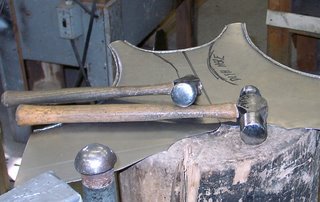

For some reason, I have never found a historical picture of an armourer working on a wooden anvil. Yet every armourer I know bashes more metal out on his wooden "stump" than on the steel anvil. The advantages are many. Wood does not scratch or dent the workpiece, it stands up to the impact very well. The wood has a certain amount of "give" to it which prevents the metal from being pinched and made too thin for its intended use. Lighter metal is often "bashed" into a sand bag. Sometimes lead shot is used instead of sand, and the heavy leather sand bag is generally about a half meter across, and rather pancake shaped. The sand bag is often laid on the surface of (you guessed it) a sawn cylinder from a tree...a stump. I like to use poplar, admittedly hard to find in the half meter (18 inches) you need to make a good dishing stump, but not impossible. The best wooden anvil is the part of the tree that causes any firewood splitter to quit when asked to reduce it to flinders. That part is the root of several boughs...or the root stump itself. The grain of the wood is not straight...it is in all directions, and so consequently difficult to split. This characterisic is a good thing when you are using a "round" to support an anvil, or to actually expect the wood to BE an anvil.
Wooden anvils are cheap, and easy to replace when the time comes, say 2 or 3 years. The wood in the picture is just about finished....a plank has been hammered out of the side of it, its starting to get unstable. I chisel divots into the surface, then flatten the end grain down with the ball of the ball peen. This leaves a "dish" into which I can push the steel. It need not be deep...say...a half inch is more than enough. One danger of useing wood is that it tends to catch grit and metal filings. These can be driven into the wood where they become almost invisible, but are a constant source of annoying scratches which will need to be buffed out later on. So don't place the wooden anvil near the drill press or sander. A second danger is that wood may carry ants or termites....who may depart their noisy abode and take up residence in the walls of your shop. I once caved in the top of a wooden anvil to find it hollow, with a half dozen terrified mice looking up at me! The stump had been unused for a year, and was being put back into service at a shopping mall demo because it looked so darned good!
You can see in the pictures how shiney the hammers are. I am getting really good at putting a polish on a hammer face...I can usually take it from factory to glossy in about half an hour. Touching up the gleam on the faces is one of those apprentice jobs....like oiling the air tools and dressing the mushroom off the struck end of a chisel.
1 comment:
Hi, If you need to succeed in life you have to upgrade your skills to a maximum level. There are lots of jobs in Hyderabad, and one can get placed with high salary. Interested persons can utilize the opportunities.
Post a Comment